SUGAR
Unraveling common questions and debunking myths
Sugar has played a pivotal role in shaping the very essence of chocolate as we know it today. From the ancient civilizations of Mesoamerica, where cacao beans were first grown and cherished without any additional sugar, to the chocolate makers of Europe, who transformed it into a luxurious indulgence. The connection between chocolate and sugar has shaped the very essence of the treat we know today. However, this craving for sugar has deeper roots that go back a few million years…
Some Sweet History
In ancient times, our ape ancestors relied on sugar-rich fruit for survival. Over time, they developed a preference for ripe fruit because it provided more glucose (read energy) due to its higher sugar content compared to unripe fruit. Sugar not only supplied energy but also played a role in fat storage. In an era when food was scarce and meals were unpredictable, holding onto fat was advantageous for survival, rather than being a health concern.
The appeal of sweetness served additional evolutionary purposes. Sugar triggers the release of dopamine, a “feel-good” chemical in the brain. This pleasurable response made sense from an evolutionary standpoint, as our ancestors who were drawn to and “hooked” on sugar had a higher chance of survival in their hunter-gatherer lifestyles.
In modern times, the same genetic tendency drives our cravings for sugar and our enjoyment of its taste. However, it raises questions about the origin and production of sugar, the variations between different types of sugar and its impact on our health.
Let’s deep dive into sugar. Unraveling the bitter truths that sugar conceals within our beloved chocolate will enlighten us about the complexities and misconceptions that exist surrounding sugar.
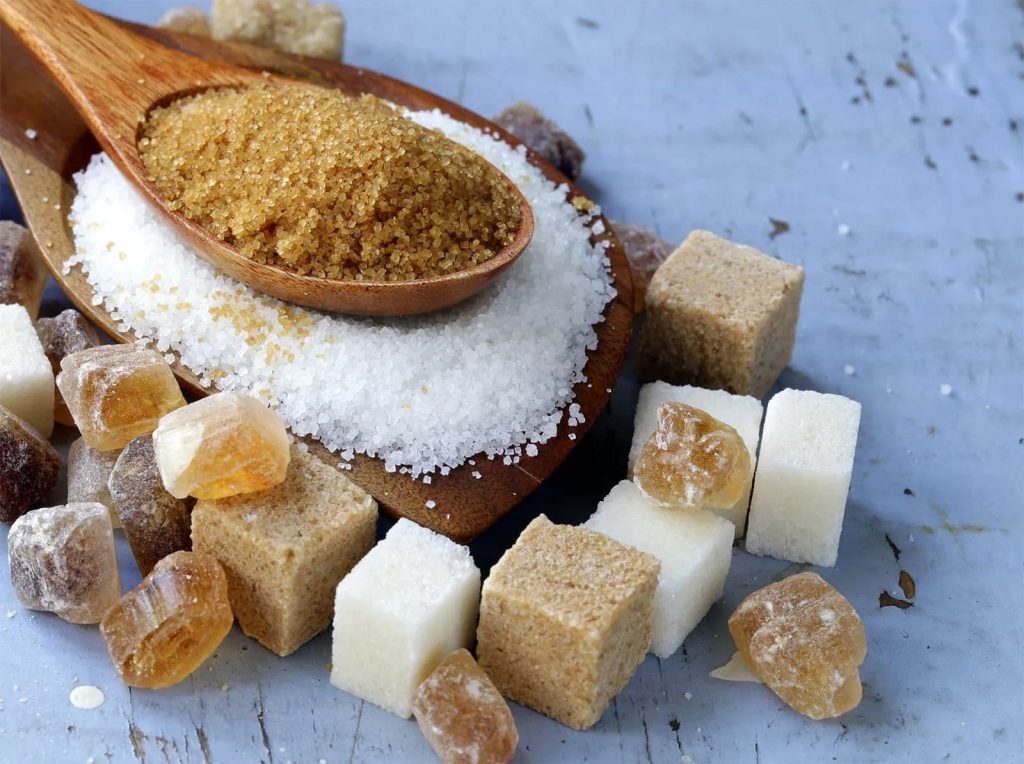
What is Sugar?
Before we can examine some of the most common misconceptions about sugar, we need to clear up the biggest misconception of all: What is sugar?
The term “sugar” can be unclear as different regulations and definitions exist. For example, the European Union defines sugar as “all monosaccharides and disaccharides present in food, but excludes polyols”. but also explains it as “purified and crystallized sucrose” in another legal context.
While both definitions are correct, they are somewhat incomplete. Sugar can be understood both as a chemically and as a product. From a chemical perspective, sugars fall under the category of Carbohydrates (Carbs). They serve as a primary source of energy for our cells, enabling them to carry out essential functions. Among the different types of sugars are glucose, fructose, sucrose, and lactose, commonly found in various foods such as fruits, vegetables, plants, honey, milk, and even cacao beans in very small amounts (between 0.8% and 1.73%).
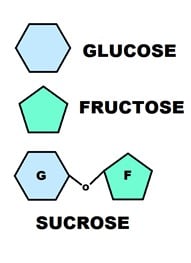
In the context of chocolate making, when people refer to sugar, they usually mean crystallized sucrose, which is the common table sugar added during the chocolate-making process.
Throughout this blog post, we will focus on this particular type of sugar.
Sugar does (not) grow on trees.
Sugar doesn’t actually grow on trees, contrary to popular belief. However, it is derived from specific trees, such as palm trees, but more on that later.
The world of sugar is quite diverse, with different names, processes, and types associated with it, which can lead to confusion. Especially when choosing the right type of sugar for specific purposes, such as adding to chocolate. Terms such as unrefined sugar, raw sugar, and unprocessed sugar can be especially tricky.
To understand the different types of sugar, it is essential to understand the process of sugar production. The biggest misconception here is that sugar can be produced in countless ways. In reality, regardless of the source, sugar generally undergoes the same basic steps during processing.
In reality, regardless of the source, sugar generally undergoes the same basic steps during processing.
- Harvesting:The first step in sugar making is harvesting (the sources). All living plants, fruits and vegetables contain sugar, but most often sugar beet and sugarcane, since they contain the most sucrose.
- Juice Extraction: After harvesting, the sugar cane stalks or sugar beets undergo a process to extract their juice. Sugar cane is crushed to release the juice, while sugar beets are sliced and soaked to extract the sugar-containing liquid.
- Purification: The extracted juice contains impurities such as plant matter, minerals, and other non-sugar compounds. The juice is then purified to remove these impurities. This is typically achieved through processes such as clarification, filtration, and chemical treatments. Lime or carbon dioxide may be added to help remove impurities.
- Evaporation: The purified juice is concentrated by heating it in evaporators, which removes a significant portion of the water content. This process creates a thick syrup called “cane syrup” or “beet syrup” that is rich in sugar.
- Crystallization: The concentrated syrup is then further processed to induce crystallization. The syrup is seeded with sugar crystals or subjected to controlled cooling, causing the sugar molecules to form crystals. The resulting mixture of sugar crystals and syrup is called a massecuite.
- Separation: The massecuite is passed through centrifuges, which separate the sugar crystals from the remaining syrup, known as molasses. The centrifuges spin rapidly, separating the crystals based on their size and density. What you end up with now is called raw sugar.
- The separated sugar crystals are washed and dried to remove any remaining molasses.
- Refining and Packaging: The dried sugar crystals are further refined to achieve the desired texture and purity. This involves processes such as milling, sieving, and sometimes the addition of anti-caking agents. Finally, the refined sugar is packaged into different forms, such as granulated sugar, powdered sugar, or sugar cubes, for distribution and sale.
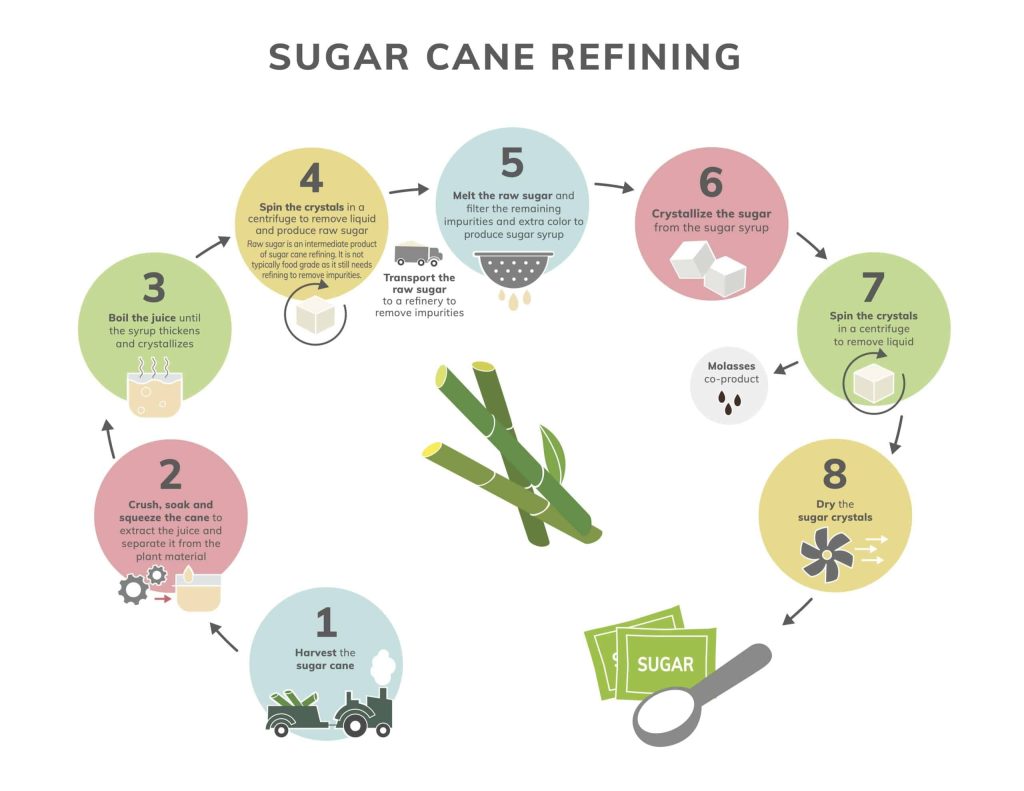
Depending on where the sugar production process is halted, different names are given to sugar:
- When the process stops at crystallization and it retains its molasses, the sugar is called refined or unprocessed sugar.
- If the sugar crystals undergo washing after crystallization, it is referred to as semi-refined sugar or raw sugars.
- Finally, when the process reaches its completion, the results is refined sugar.
Sugar Sources – Breakdown Overview
With many different types of sugar, including white sugar, brown sugar, panela, turbinado, demera sugar, muscovado sugar etc., it is often believed that these sugars come from various sources. However, this is incorrect.
Almost all sugars come from the following three sources: sugar cane (accounting for approximately 79% of the world’s sugar volume), sugar beet (accounting for around 20%), and palm trees, which contribute for only a very small amount (approximately +-1%).
SUGAR CANE
Cane sugar is a type of sugar derived from sugar cane, a tall grass grown mainly in tropical and subtropical regions. With an annual volume of 1859 million tons, it accounts for 80% of the world’s sugar production.
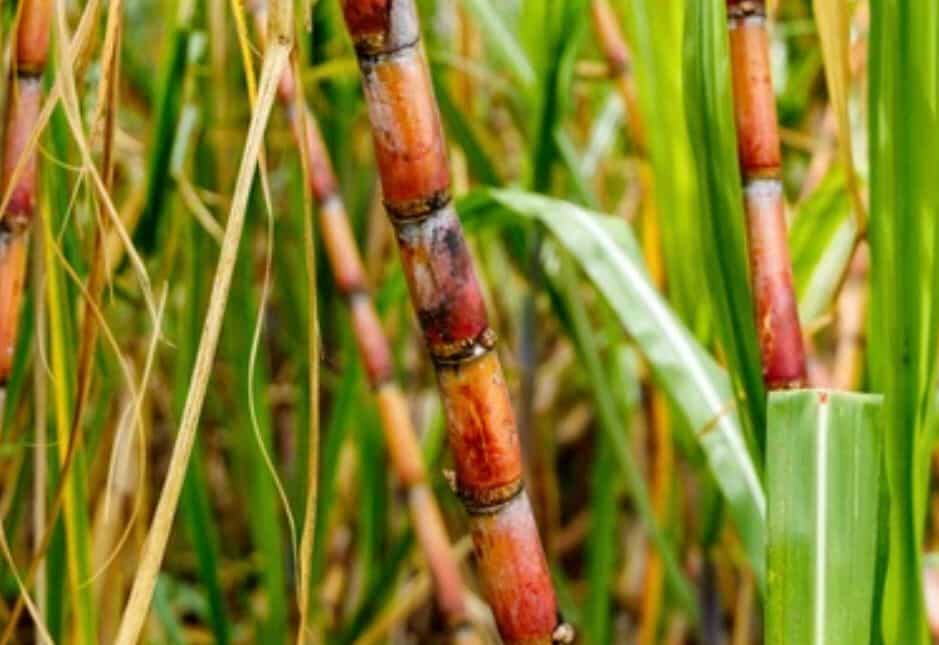

Cane sugar is naturally brown in color due to the presence of molasses, which is a byproduct of the sugar extraction process. The molasses imparts a distinct flavour and aroma to cane sugar, giving it a characteristic sweetness and richness.
The unrefined sugar can then be further refined in various steps, ending up in the white sugar we all know. By then, the sugar is 99.5% sucrose.
WORLD VOLUME
in 2021: 1859 million metric tons
ORIGIN
Grows in more than 100 countries but the biggest five -responsible for 70% of the total volume- are: Brazil: 41,3%, India: 18,7%, China: 6.6%, Thailand: 4.7%.
TYPES OF CANE SUGAR
- Granulated Cane Sugar: This is the most common and widely used form of refined cane sugar. It consists of fine, white sugar crystals with a uniform texture. It is versatile and commonly used in baking, cooking, and sweetening beverages.
- Caster Sugar: similar to granulated sugar, but with a finer structure, so that it easier dissolves in fluids.
- Confectioners’ Sugar (Powdered Sugar): This is a finely ground refined cane sugar that has been further processed into a powdered form. It is often used in frosting, icing, and confectionery preparations.
- Brown Sugar: Brown sugar is a type of refined cane sugar but with molasses added, giving it a moist texture and a distinctive flavour. It ranges in color from light to dark brown and is commonly used in baking, sauces, and marinades.
- Demerara Sugar: Demerara sugar is a type of raw cane sugar that that retains some original molasses and impurities. It has large, amber-coloured crystals and a rich, caramel-like flavour. It is often used as a sweetener and a topping for desserts, baked goods, and beverages.
- Turbinado Sugar: Turbinado sugar is another type of raw cane sugar with larger crystals and a pale golden color. It has been spun in a centrifuge to remove almost all of the molasses.
- Muscovado Sugar: Muscovado sugar is a raw cane sugar with a high molasses content. It has a moist texture, dark brown colour, and a strong, robust flavour.
- Panela: Panela sugar is an unrefined cane sugar commonly found in Latin American countries. It retains its natural molasses and minerals, giving it a rich, caramel-like flavour with subtle notes of toffee and a hint of bitterness.
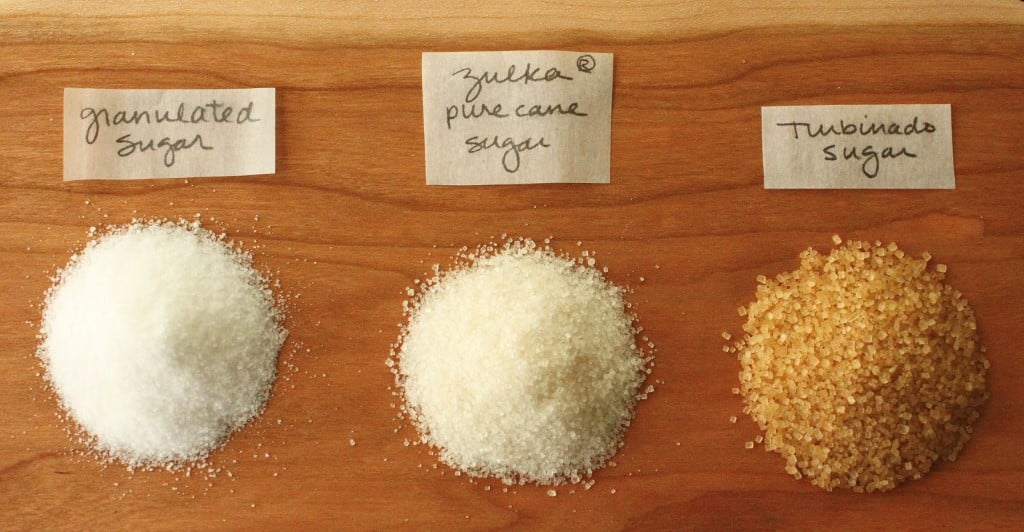
SUGAR BEET
Beet sugar is derived from sugar beets, a root vegetable cultivated in temperate regions that are usually too cold for sugar cane. However, in recent times, they have successfully transitioned into becoming a winter crop in the warmer reaches of the temperate zones, extending their cultivation to diverse regions such as South America, Africa, the Middle East, and southern Europe.
Beet sugar production accounts for the remaining 20% of the world’s sugar production, with an annual volume comparable to cane sugar.
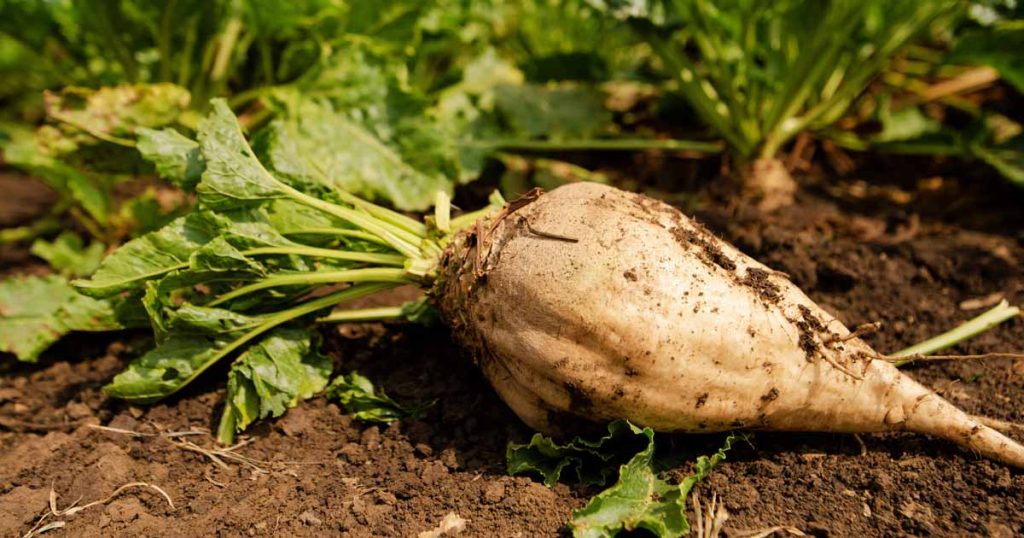
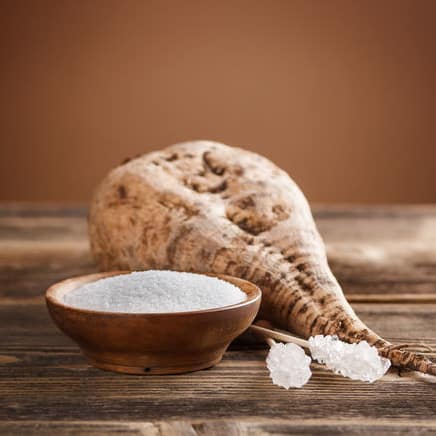
Unlike cane sugar, beet sugar starts as a white, crystalline substance. Sugar beets naturally contain a higher concentration of sucrose compared to sugar cane, allowing for a more direct extraction process.
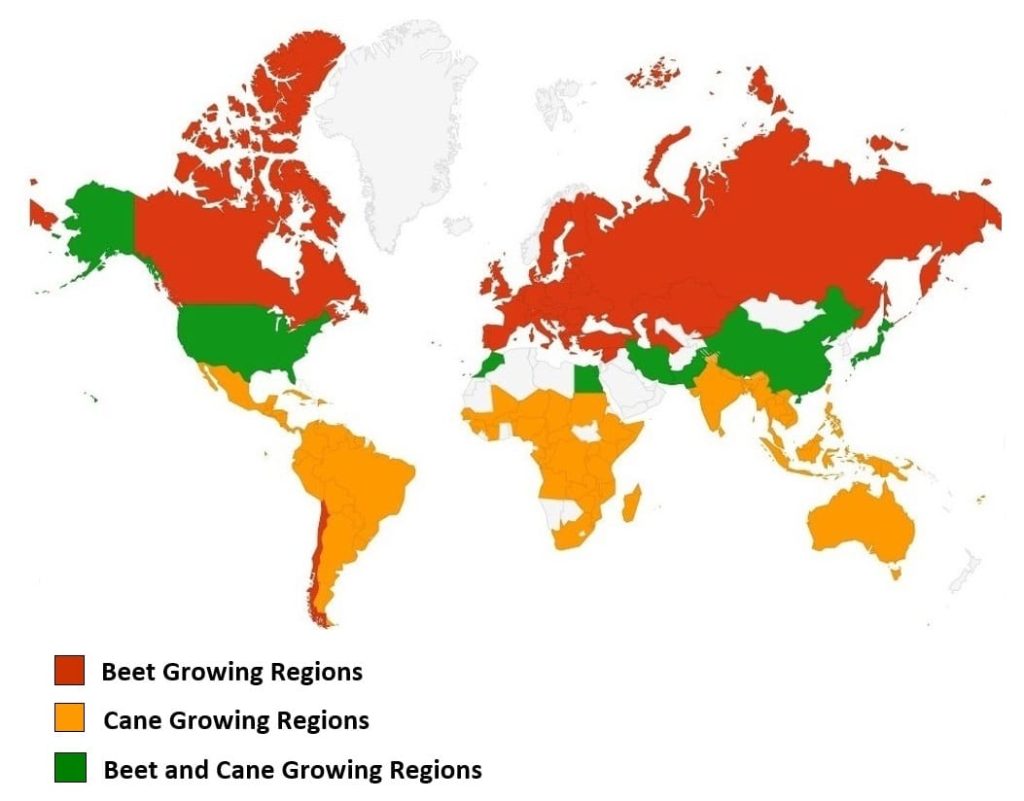
WORLD VOLUME
in 2021: 271 million metric tons
ORIGIN
The biggest eight countries, responsible for 70% of the total volume are Russia, France, Germany, USA, Turkey, Poland, Egypt & China.
TYPES OF BEET SUGAR
- Granulated Beet Sugar
- Caster Sugar
- Confectioner’s Sugar
- Brown sugar
PALM SUGAR
Palm sugar is a natural sweetener derived from the sap of various palm trees. It is a traditional sweetener commonly used in Southeast Asian cuisines, particularly in countries like Indonesia, Thailand, Malaysia, and the Philippines. Palm sugar has a distinct flavour profile, often described as rich, caramel-like, and with hints of toffee or butterscotch.
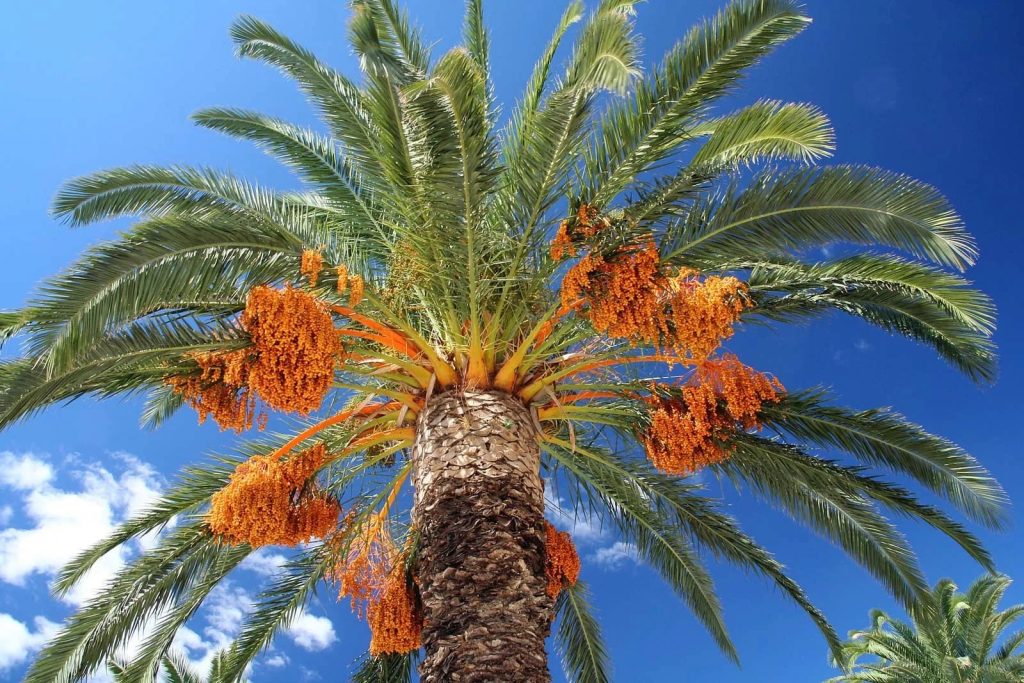

WORLD VOLUME
The world’s palm tree volume cannot be precisely determined due to the existence of more than 2600 palm tree varieties, each with various uses.
ORIGIN
Palm trees usually thrive in tropical and subtropical climates, but some species have been successfully grown in cooler regions like the UK, The Netherlands, and Belgium.
TYPES OF PALM SUGAR
- Coconut Palm: This type of palm sugar is made from the sap of coconut palm trees and is grown in Southeast Asia, especially in coastal areas of the Indian and Pacific Oceans. It is known for its subtle flavour and is available in granulated or block form.
- Arenga Palm: Also called, sugar palm. It grows in the coastal regions of Asia, mainly China, Malaysia and Indonesia. Derived from the sap, this type of palm sugar is popular in Indonesia. It has a darker color and a richer flavor compared to coconut palm sugar.
- Date Palm: Made from the sap of dried dates, this type of palm sugar is common in the Mediterranean and the Middle East. It has a unique sweetness with a distinct date flavor.
- Palmyra Palm: Produced from the sap of the palmyra palm tree’s flower. This palm grows in Africa, Asia and New Guinea. It’s sugar is used in South Asian cuisines. It has a dark color and a pronounced molasses-like taste.
- Nipa Palm: The Nipa Palm is native to coastal and tropical regions of the Indian and Pacific Ocean. Extracted from the sap of the nipa palm tree’s flower, this type of palm sugar is found in Southeast Asia and is commonly used in local desserts and beverages.
Popular Misconceptions about Sugar & Health Explained
For dessert we serve you some popular misconceptions about sugar & health:
Natural sugars are healthier than added sugars
While natural sugars found in fruits and vegetables come with essential nutrients and fiber, excessive consumption can still contribute to health issues like weight gain and tooth decay. Added sugars in processed foods, on the other hand, offer little to no nutritional value.
Raw sugar is healthier than processed sugar
With its light caramel tint and nuggety shape, raw sugar is very enticing. This organic sweetener is less processed than table sugar and can be found in a variety of health-related items, so it must be better for you. It isn’t, in fact.
Some proponents of raw sugar argue that the molasses left in the raw sugar includes vital elements that our bodies can utilize. However, most specialists believe that only trace minerals remain, which are insignificant amounts that have no effect on human health. Also, just for the record: The calories in raw sugar and refined sugar are the same. So, while they’re processed in different ways, they’re essentially the same.
Sugar is just as addictive as drugs
Sugar is often compared to addictive substances such as drugs because of its ability to activate the brain’s reward system. While some research suggests that sugar can trigger certain addictive responses, it is essential to understand that sugar addiction is not comparable to drug addiction in terms of severity and consequences.
Sugar-free products do not affect blood sugar levels
Sugar-free does not mean carbohydrate-free. Many sugar-free products contain other carbohydrates, such as starches and fiber, that can still affect blood sugar levels.
Short & Sweet Takeaways

Unraveling the mysteries and misconceptions of sugar has shown us its profound influence on human history and evolution. From its ancient role in sustaining our ape ancestors to its association with the luxurious indulgence of chocolate, sugar has left an indelible mark on our culinary journey.
Understanding the origins and production processes of various sugars highlights the diversity of sources but also the fundamental similarities in their processing. Ultimately, regardless of the source, sugar consumption should be approached with moderation and awareness of individual health needs.
As we navigate the complexities of sugar and its impact on our lives, a balanced approach to its consumption will empower us to enjoy the sweetness it adds to our culinary delights while safeguarding our well-being and overall health.
For those looking to reduce sugar in their chocolate, a smart strategy is to choose cacao beans that possess natural sweetness and lower bitterness. This simple adjustment paves the way for the creation of a perfect bar with reduced sugar content.
